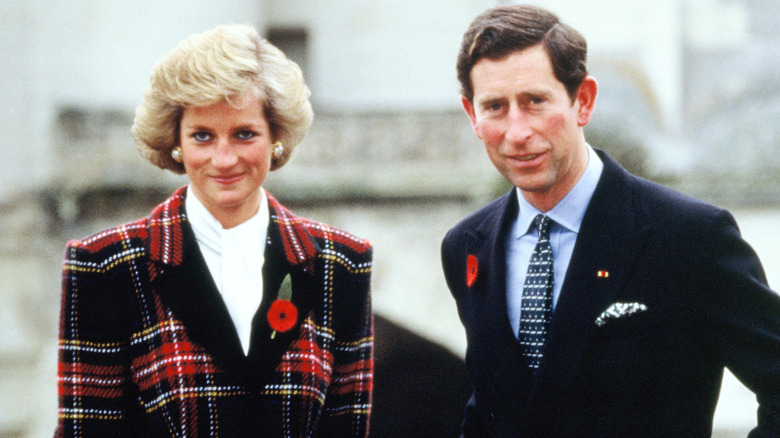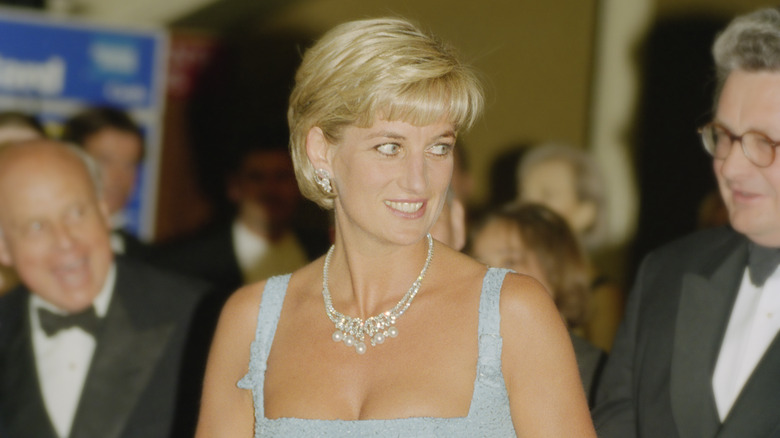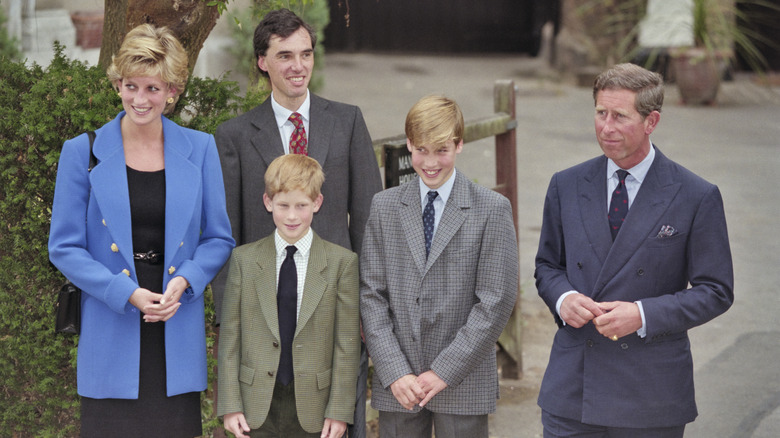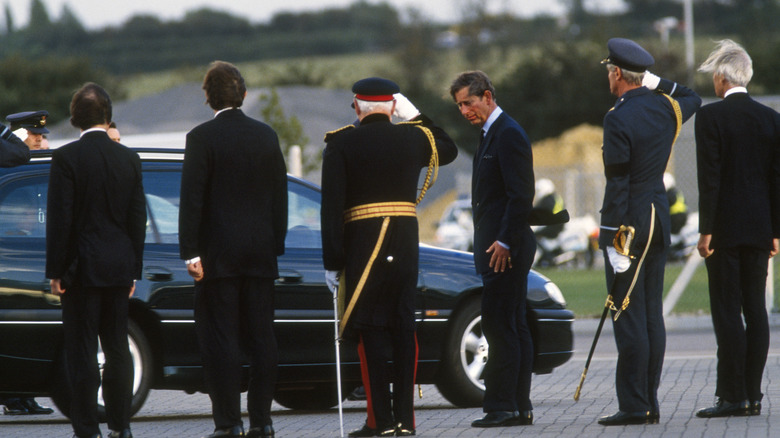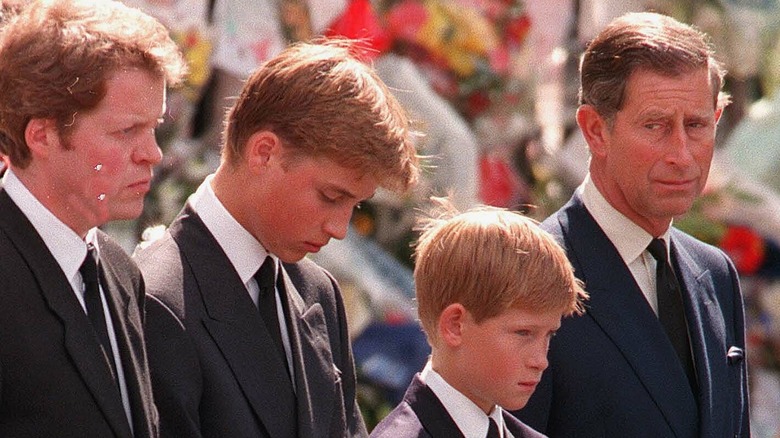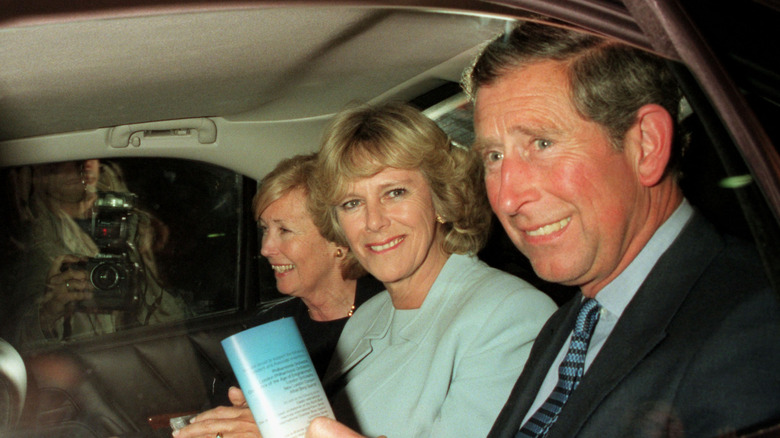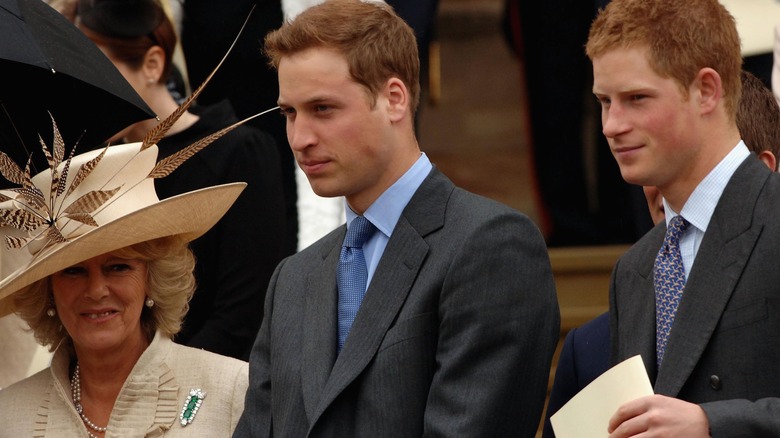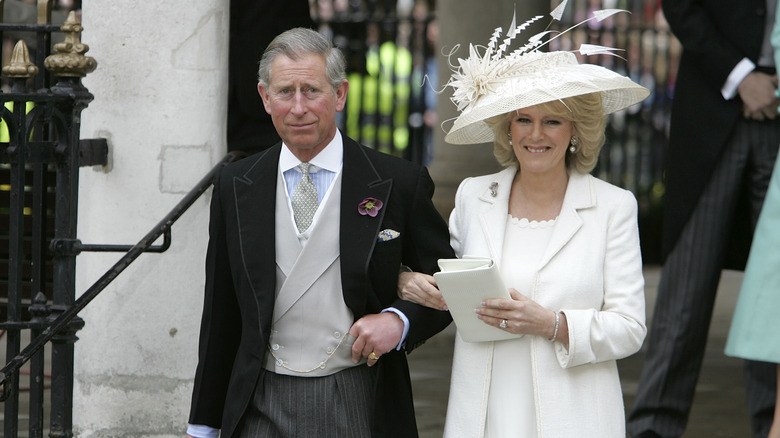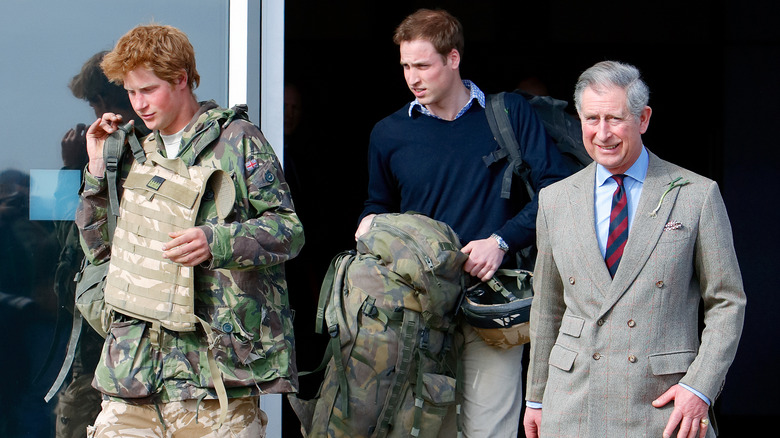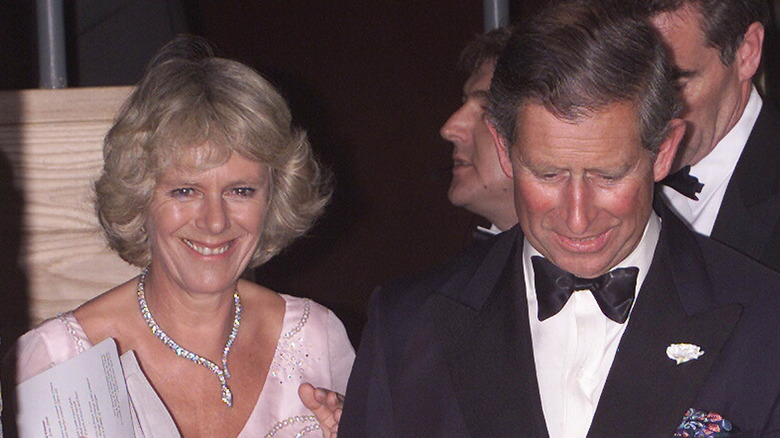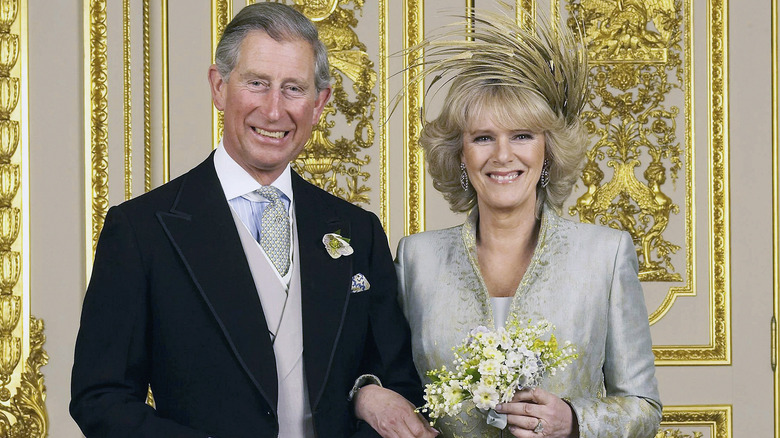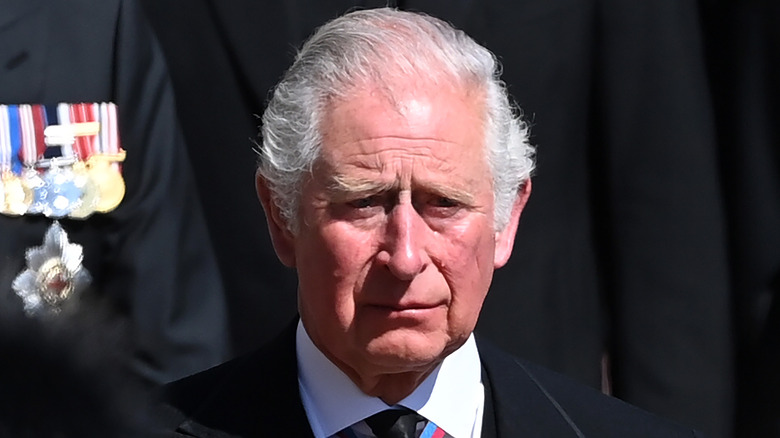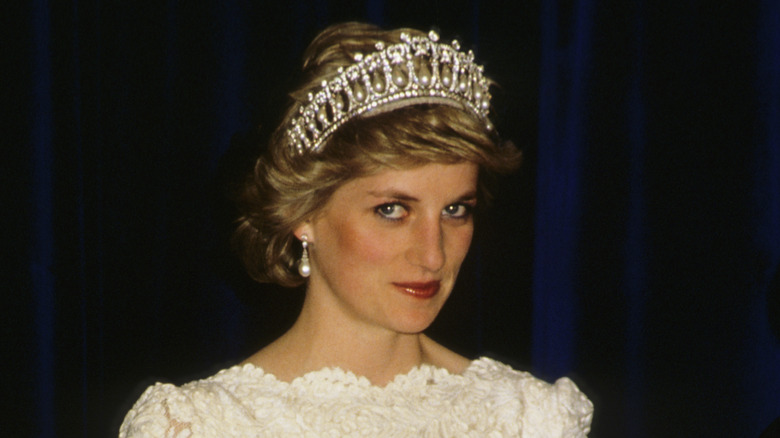King Charles' Life Was Never The Same After Diana Died
While it's been more than 25 years since Diana Spencer tragically died at 36, her legacy — and impact — lives on. Having been immortalized on-screen and meaningfully remembered by her sons, Prince William and Prince Harry, the late Princess of Wales is just as beloved today as she was at the height of her fame. When the people's princess succumbed to injuries sustained in a car accident in Paris in 1997, it truly seemed the world was united in shock. Mourners quickly flocked to the royal sites in England — Kensington and Buckingham Palaces specifically — and left heaps of flowers, tributes, photographs, and messages to the late princess. To this day, the visuals capturing the outpouring of grief live on, only furthered by the devastated looks on William and Harry's faces while greeting crowds and taking in the tragic moment.
United with his sons in grief was King Charles III, then the Prince of Wales, who had been married to Diana for over a decade. While the marriage between Diana and Charles was fraught with tension, drama, and allegations of infidelity, the now-monarch felt the same pain and sadness as mourners gathered outside the palace. With decades passed — and marriages, grandchildren, and drama surrounding the royal family — it's easy to see Charles as having nothing but ease around him. Still, his life was significantly impacted when Diana passed, and he navigated the aftermath, all while in the public eye.
Charles and Diana were already divorced when she passed
When King Charles III and Diana Spencer tied the knot, it seemed millions were watching a real-life fairytale play out in real time — the dress, the flowers, and the adoring fans were just glimpses of two royal lives joining. But the dream-like state spectators were in was quickly shattered, as Diana and Charles' marriage was fraught with scandal, cheating allegations, and tension. By 1992, the pair had formally separated, and while divorce never seemed to be in the cards for the then-Prince and Princess of Wales, their union officially ended in 1996.
As The New York Times noted, as the pair reached a formal agreement, Diana walked away from negotiations with a considerable settlement — $22.5 million in cash and $600,000 yearly payments — and her title as Princess of Wales. One of the biggest kicks, however, came to her royal status. The outlet noted that it was Charles who demanded Diana be stripped of the Royal Highness title, a moniker that set her apart as a royal. Queen Elizabeth II was said to have supported Diana keeping the designation, but Charles was "adamant that she give it up."
Once stripped of her HRH status, Diana was expected to curtsy to other royals — including her sons. However, the royal family made it clear that Diana would always be "regarded as a member of the royal family" and "from time to time receive invitations to state and national public occasions."
Diana and Charles' relationship had improved shortly before she died
While King Charles III's life was certainly impacted by his divorce from Diana Spencer in 1996, the two took steps to repair their bond shortly before the princess's death. Diana was famously in a relationship with Dodi Al Fayed after her marriage to Charles ended, and the royal himself was said to be supportive of the pairing. As reported by People at the time, Charles said of Diana and Dodi's relationship, "I'm happy if she's happy" — a far cry from the tension that plagued Charles and Diana's early relationship.
Things didn't end there, either. As recalled by New Yorker editor Tina Brown to The Telegraph – who met Diana for lunch in the summer of 1997 — Diana and Charles "were on the best terms they'd been for a very long time" after their divorce proceedings came to an end. They had even made a practice to check in on one another.
"Charles got into the habit of dropping in on her at Kensington Palace, and they would have tea and a sort of rueful exchange," Brown shared. "They even had some laughs together." What could've happened to smooth things over so beautifully between the once-warring couple? Brown shared that as their children were growing up and Diana had come to terms with Camilla Parker Bowles' presence in Charles' life, the formerly married couple were seeing more eye-to-eye.
Charles made the tragic trip to Paris to retrieve Diana's body
Diana Spencer's life was tragically cut short in August 1997. The princess was fleeing the paparazzi in Paris when her car crashed in the Pont D'alma tunnel, severely injuring her and the vehicle's occupants. After the accident, the princess slipped into cardiac arrest, and doctors spent more than two hours trying to revive her, but to no avail. As noted by AP News, Diana succumbed to her injuries at 4 a.m. and was pronounced dead at Paris' Hospital de la Pitie Salpetriere. The following day, King Charles III arrived in Paris and collected Diana's remains. The public display of sorrow kicked off an outpouring of grief worldwide.
AP News noted that Charles accompanied a flag-draped coffin as it left the hospital, joined by Diana's two sisters and former French President Jacques Chirac and his wife. Another flag — the Royal Standard, also known as the personal flag belonging to the royal family — was placed on Diana's coffin, and the mourning group made their way to an airfield just outside Paris.
Charles not only traveled to Paris to collect Diana's body but was also responsible for telling his sons, Prince William and Prince Harry, that their mother had died. Just 15 and 12 at the time, William and Harry were at Balmoral in Scotland when the news broke and were said to be "deeply shocked and distressed by this terrible news."
It was thanks to Charles that Diana had a royal funeral
While Queen Elizabeth II kept her opinions and personal strife to herself with the classic British stiff upper lip, she did make it clear that 1992 — the year King Charles III and Diana Spencer separated — was significantly awful. With that in mind, it might not be a huge shock to learn that the late queen reportedly did not want to give Diana a public royal funeral and pushed for a private ceremony for family only instead. As noted by The New York Times in the immediate aftermath of Diana's death, Charles was the one to demand a public funeral for his ex-wife, proving that even in their time of separation, he respected her memory and public legacy.
As a television news report noted shortly after Diana's death, Charles and the queen "disagreed so vehemently" on funeral arrangements that former Prime Minister Tony Blair had officials sent to "mediate" conversations between them. While Buckingham Palace denied the report, calling it "mischief-making," The Sun also reported similar circumstances unfolding behind closed doors.
It wasn't just Charles who was said to be upset at the queen's specification for a private funeral for Diana, either. Diana's family, The New York Times reported, was so upset at the monarch for pushing for a private funeral that "they initially refused to communicate with her and palace officials.
Charles had to abandon plans to reintroduce Camilla to the public
The fact that King Charles III was having an affair with Camilla Parker Bowles throughout his marriage to Diana Spencer was the worst-kept secret in Britain. Even from the onset of his relationship with Diana, Charles was sending Camilla gifts, chatting with her on the phone, and making it clear that she was the woman of his affectionate desires.
By 1986, Camilla and Charles' relationship was confirmed to be back on, and Diana was acutely aware of this. In her infamous PBS interview with Martin Bashir, Diana admitted that "three of us" were in the marriage, referring to Camilla and the irrefutable breakdown her marriage endured. Of course, Charles and Diana got divorced in 1996, and Camilla had since split from Andrew Parker Bowles, her first husband. The duo — who had known each other for decades — were finally able to be together, but Diana's death changed their plans immensely.
As noted by The Guardian, Charles' 50th birthday party in November 1997 could have been the launching pad for Camilla to re-enter high society by the royal's side. Still, Diana's tragic death in August forced Charles to "abandon" his plans to "introduce" Camilla to the public again. Such a rollout didn't come to fruition. Even after she married Charles, Camilla never publicly used the Princess of Wales title out of respect for its historical tie to Diana.
The king had to introduce his sons to Camilla amid their grief
When Diana Spencer's life was cut so tragically short, her sons — Prince William and Prince Harry — were only 15 and 12 at the time. Watching the boys walk behind their mother's coffin was one of the saddest sights to behold, as thousands of mourners cried alongside them. Perhaps even more jarring for the young princes was their father's relationship with Camilla Parker Bowles, transcending their mother's marriage to him and the time following her death.
As noted by The Guardian, King Charles III was all but forced to introduce his children to his long-time mistress, as William had paid an unexpected visit to his father while Camilla was with him. Awkwardly meeting each other for the first time at St. James's Palace, a 16-year-old William and Camilla exchanged pleasantries for about half an hour before the now-Prince of Wales left. "Meetings between the children and Mrs. Parker Bowles are a private family matter, which we are not prepared to discuss, and we hope for their sakes, the media will now leave this very personal matter alone," a spokesperson for Charles said in the aftermath of the meeting, as it gained quite a bit of attention given its timing — Diana had been dead for less than a year.
Charles's public image was still tainted even after Diana's death
When King Charles III finally admitted to having an affair, it confirmed the rumors everyone knew to be true. Sitting down for an interview with British journalist Jonathan Dimbleby in 1994, Charles confessed that he had been faithful to his wife "until [the marriage] became irretrievably broken down, us both having tried." What ensued, The New York Times reported at the time, was the reopening of "old wounds" that the public was trying to come to grips with, given that Charles had been marred with scandal for years — not the reputation a one-day king wants. "In one stroke, he's wiped out all the good will he's built up over 12 months," Brian Hoey, a royal biographer, said at the time, the interview airing about three years before Diana's death.
As Charles emerged somber and bereft following his ex-wife's death, such sympathy and understanding were far more granted to his sons than to the royal himself; Charles' reputation was still negatively impacted given his infidelity and the rumors that circulated about his mistreatment of Diana Spencer. The public, ABC News noted, expressed an "outpouring of grief" and "anger" directed at Charles and the royals. Only about half a decade later, Charles' image started to mend.
Harry's teenagehood and early adulthood proved challenging for King Charles
Helping any teenager navigate the difficulties that come with age can be challenging. Prince Harry, in particular, took the loss of his mother tough — something that he has been more vocal about since leaving the royal family — and his habits as a teenager took the royal family by surprise.
As noted by The Guardian, King Charles III discovered that Harry had been "regularly smoking cannabis and drinking alcohol" at just 16 years old and decided that the best course of action would be to send Harry to rehab. The king didn't intend for his son to stay there for a prolonged period but wanted Harry to see the consequences that drugs and alcohol can have. Harry's admission was seen as "highly embarrassing" for the royal family at the time and brought up questions about the young prince's ability to process losing his mother at such a young age.
Things didn't stop there for Harry, either. About four years later, the 20-year-old prince was photographed wearing a Nazi uniform — swastika armband and all — during a party. The cigarette in between his fingers was icing on the cake. "I think a lot of people will be disappointed to see that photograph, and it will cause a lot of offense," Michael Howard, then-leader of Britain's Conservative Party, told The New York Times. Clearly, Charles' life as a single father was anything but easy.
Charles had to deal with a number of hurdles while bringing Camilla into the royal fold
In the wake of Diana Spencer's death, it became clear that her influence and popularity would long outlive her. King Charles III, meanwhile, appeared to be floundering in his personal life, as the then-unmarried heir to the throne was still connected to Camilla Parker Bowles. His journey to bring her into the royal family would be anything but easy, Vanity Fair noted, and Queen Elizabeth II herself had a big request for her son's private secretary.
Sir Michael Peat assumed the role of Charles' right-hand man in 2002, and while it sounds like a secretary would keep the books and make sure all the phone calls are answered, Peat's plan was said to be far more sinister. According to reports, he was told by the queen herself that his priority was to break up Charles and Camilla — sounding more like an elaborate plot of a soap opera rather than the real-life comings and goings of one of the most influential families in the world.
As it happened, Charles had already attempted to bring Camilla into the royal fold in the months following Diana's death in 1997, People noted, but it was to no avail. The queen was said to have had several martinis when Charles approached her about the subject and told her son that Camilla was a "wicked woman" with which she wanted "nothing to do."
Camilla and Charles were finally able to get married after decades of being together
Perhaps one of the most apparent ways King Charles III's life changed after Diana Spencer's death came in 2005. After decades of knowing one another and being involved in extramarital affairs, Charles and Camilla Parker Bowles finally married in a civil ceremony at Windsor, Hello! Magazine noted. The wedding was not without judgment, however, as Queen Elizabeth II made a point of not attending the nuptials. Given her role as the then-head of the Church of England, the queen thought it would be inappropriate to participate in the wedding of two divorcees, as the church does not condone divorce in the first place. Putting the crown above family again, Elizabeth did not shy away from her responsibilities — but it certainly left people wondering if other motives (such as a dislike for Camilla) made her sit out of the day's happy event.
Despite any rumored tension, Queen Elizabeth II and Prince Philip hosted a reception for Charles and Camilla following their April 9 wedding, with the queen sharing heartfelt words with the newlyweds.
"Despite ... terrible obstacles, my son has come through, and I'm very proud and wish them well," the queen said, as noted by The Globe and Mail. "The couple have finally arrived in the winner's enclosure," she continued, nodding to her beloved horse racing hobby.
The king dealt with revived criticism after Diana's story was told on-screen
Though it's decades since Diana Spencer's death, her influence is just as prominent as ever. More information has been released about Diana's struggles within the royal family, and her story has been immortalized on-screen for everyone to see.
Perhaps one of the most prominent sources of royal family-based drama is Netflix's "The Crown" – a retelling of the royals amid Queen Elizabeth II's reign that has thousands upon thousands of fans. The streaming giant has made it clear that "The Crown" is a dramatized telling of the royal stories, but fans met King Charles III and Camilla Parker Bowles with vitriol online when the show's fourth season dropped.
Predominantly focusing on Diana and Charles' early relationship and marriage, Season 4 of "The Crown" brought Diana's struggles with bulimia, her cries for help, and Charles' affair to the spotlight (however factual to how things played out). Viewership was so high — and so impassioned — that the Twitter comments on Charles and Camilla's joint account were turned off. Before Clarence House had the chance to disable comments on a Twitter post from November 2020, around the time of the Season 4 drop, Diana's staunch defenders got a word in. "Something is wrong with him. How could any man walk away from [an] extremely gorgeous, fabulous, and stylish woman," one person commented to another, "[Camilla will] never be like Diana."
King Charles' ascension to the throne was clouded by Diana's memory
When Queen Elizabeth II passed away on September 8, King Charles III immediately took the throne. It's a role that he has been preparing for his entire life, and while some may have been happy to see him take over the monarchy, many others were quick to focus on Diana Spencer amid her ex-husband's ascension. As noted by Insider, many videos — predominately on TikTok — popped up in the immediate aftermath of Charles' ascension, focusing on Diana as the "real queen" of Britain, as opposed to Camilla Parker Bowles. The hashtag "Cowmilla" even saw quite a bit of traction.
Still, others — even those who knew Diana — were quick to point out that fans of the late princess should tone down the online bullying. Grant Harrold, a former butler to King Charles, told Insider, "There are always going to be people who love Diana — that's not going to change," and that fans should support Camilla and Charles. His comments were bolstered by former royal chef Darren McGrady, who said, "A lot of the country still adore Diana... you know, if things had gone to plan, we would have Queen Diana right now. They didn't. But he's been married for 17 years now, and Camilla seems to be that stability in his life."
